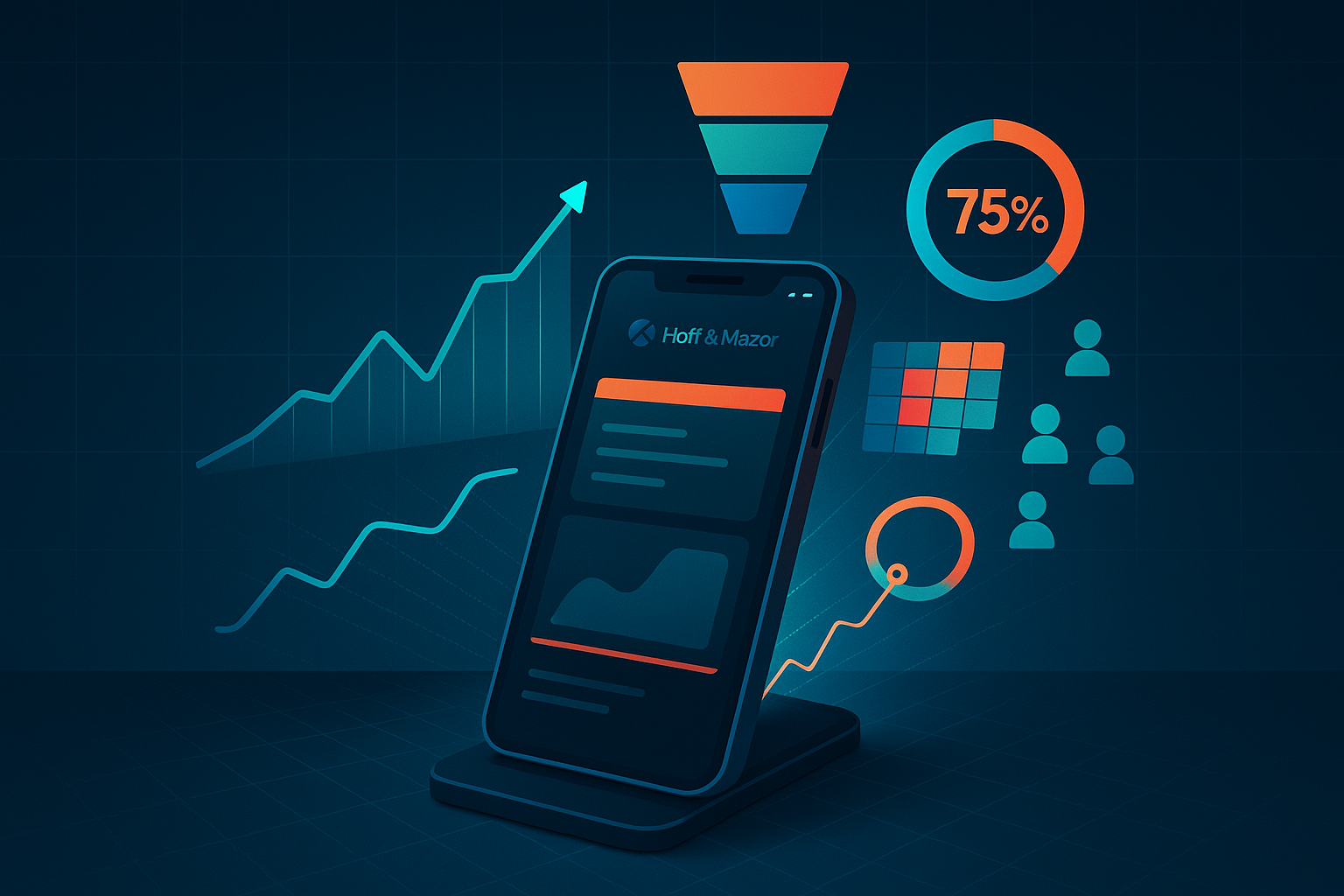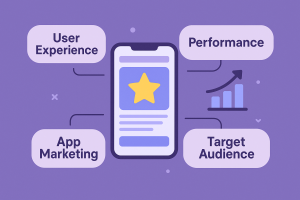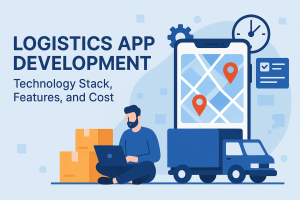Mobile applications have become essential tools for businesses looking to engage with customers and drive growth. However, simply launching an app isn’t enough to guarantee success. The key lies in understanding user behavior, optimizing performance, and making data-driven decisions. This case study explores how Hoff & Mazor, a leading mobile app development company, transformed their client’s business by implementing robust analytics strategies.
Introduction to Hoff & Mazor and the Client
Hoff & Mazor has established itself as a premier offshore mobile app development partner for businesses seeking innovative digital solutions. With a team of expert developers and analysts, they specialize in creating custom applications that not only look good but perform exceptionally well.
The client in this case study was a mid-sized e-commerce retailer looking to expand their digital presence beyond their website. They approached Hoff & Mazor with a clear objective: create a mobile application that would increase customer engagement, boost sales, and provide valuable insights into consumer behavior.
The Challenge: Identifying Growth Opportunities
The client’s initial app launch showed promising download numbers, but several challenges quickly emerged:
- User Retention Issues: While download numbers were strong, retention rates after the first week dropped significantly.
- Conversion Rate Problems: Despite high traffic, the conversion rate from browsing to purchase was below industry standards.
- User Experience Concerns: Customer feedback indicated navigation issues and confusion about certain features.
- Limited Data Visibility: The existing analytics setup provided only basic metrics without actionable insights.
- Performance Bottlenecks: The app experienced occasional slowdowns during peak usage times.
To address these challenges, Hoff & Mazor needed to implement a comprehensive analytics strategy that would provide deeper insights into user behavior and app performance. The goal was to identify specific areas for improvement and develop data-driven solutions to drive growth.
Analytics Implementation Strategy
Hoff & Mazor began by conducting a thorough assessment of the client’s existing analytics setup. They discovered that the client was using a basic analytics package that tracked only superficial metrics like downloads and opens. To gain deeper insights, they needed a more sophisticated approach.
The team developed a multi-layered analytics implementation strategy:
1. Comprehensive Analytics Framework
The first step involved setting up a robust analytics framework that could capture data at various points throughout the user journey. This included:
- User Acquisition Analytics: Tracking where users came from and which marketing channels were most effective.
- Behavioral Analytics: Understanding how users navigated through the app and which features they engaged with most.
- Conversion Analytics: Identifying the paths that led to successful purchases versus abandoned carts.
- Retention Analytics: Measuring how often users returned to the app and what triggered their return.
- Performance Analytics: Monitoring app speed, crash rates, and other technical metrics.
2. Custom Event Tracking
Beyond standard metrics, Hoff & Mazor implemented custom event tracking to capture specific user interactions that were particularly relevant to the client’s business model. These included:
- Product view duration
- Add-to-cart actions
- Wishlist additions
- Search queries
- Filter usage
- Category browsing patterns
- Payment method selection
- Checkout abandonment points
3. Segmentation Capabilities
To provide more nuanced insights, the analytics system was configured to segment users based on various criteria:
- Demographic information
- Geographic location
- Device type and operating system
- User acquisition source
- Purchase history
- Engagement level
- Feature usage patterns
4. A/B Testing Infrastructure
Hoff & Mazor also implemented an A/B testing framework that allowed the client to experiment with different features, layouts, and user experiences to determine which versions performed best. This capability was crucial for making data-driven decisions about app improvements.
The implementation of these analytics tools required careful consideration of mobile app architecture principles to ensure that the data collection process didn’t negatively impact app performance or user experience.
Key Performance Indicators and Metrics
To measure success and track progress, Hoff & Mazor worked with the client to establish key performance indicators (KPIs) that aligned with business objectives. These metrics provided a framework for evaluating the effectiveness of app optimizations and feature updates.
Primary KPIs:
- Monthly Active Users (MAU): The number of unique users who engaged with the app each month.
- Retention Rate: The percentage of users who returned to the app after their first visit at various intervals (1-day, 7-day, 30-day).
- Session Duration: The average amount of time users spent in the app per session.
- Conversion Rate: The percentage of users who completed a purchase after browsing products.
- Average Order Value (AOV): The average monetary value of each purchase.
- Customer Lifetime Value (CLV): The predicted revenue a single user would generate throughout their relationship with the app.
Secondary Metrics:
- Screen Flow: The sequence of screens users navigated through during their session.
- Feature Adoption Rate: The percentage of users who engaged with specific app features.
- Cart Abandonment Rate: The percentage of users who added items to their cart but didn’t complete the purchase.
- Search Success Rate: The percentage of searches that resulted in users finding and selecting products.
- App Load Time: The time required for the app to load and become fully functional.
- Crash Rate: The frequency of app crashes relative to the number of sessions.
By focusing on these metrics, the team could identify specific areas for improvement and measure the impact of their optimizations.
Data Collection and Analysis Process
Collecting and analyzing data effectively required a structured approach. Hoff & Mazor implemented a comprehensive data management system that ensured data accuracy, consistency, and accessibility.
Collection Methodology:
- SDK Integration: Analytics SDKs were carefully integrated into the app code to collect user behavior data without compromising performance.
- Server-Side Tracking: Certain events were tracked server-side to capture actions even when users were offline.
- Event Taxonomies: A standardized naming convention for events was established to ensure consistency in data collection.
- Data Validation: Automated checks were implemented to validate incoming data and flag anomalies.
- User Consent Management: Systems were put in place to respect user privacy preferences and comply with regulations like GDPR.
Analysis Techniques:
The collected data was analyzed using various techniques to extract meaningful insights:
- Funnel Analysis: Examining conversion paths to identify drop-off points in the user journey.
- Cohort Analysis: Grouping users based on common characteristics to understand retention patterns.
- Heatmaps: Visualizing user interactions to identify popular features and potential pain points.
- Session Recordings: Reviewing anonymized user sessions to observe navigation patterns and usability issues.
- Correlation Analysis: Identifying relationships between different behaviors and outcomes.
One significant advantage of Hoff & Mazor’s approach was their expertise in mobile app performance optimization, which allowed them to gather detailed analytics data without slowing down the application or causing technical issues.
Actionable Insights and Implementations
The analysis of collected data revealed several critical insights that guided improvements to the client’s mobile application:
Insight 1: Onboarding Friction
Finding: Data showed a significant drop-off (45%) during the registration process, particularly at the point where users were asked to provide detailed personal information.
Implementation: Hoff & Mazor redesigned the onboarding process to use a progressive approach, asking only for essential information upfront and gradually collecting additional details over time. They also implemented social login options to streamline the process.
Result: The registration completion rate improved by 32%, significantly increasing the number of new users entering the sales funnel.
Insight 2: Product Discovery Challenges
Finding: Analysis of search queries and navigation patterns revealed that users were struggling to find relevant products, with 28% of searches resulting in zero results.
Implementation: The team enhanced the search functionality with autocomplete suggestions, improved filters, and personalized recommendations based on browsing history. This approach leveraged principles from building scalable mobile apps to ensure the new features performed well.
Result: The search success rate increased by 40%, and the average time to find products decreased by 22 seconds.
Insight 3: Checkout Abandonment
Finding: Funnel analysis showed a 67% abandonment rate during the checkout process, with a significant drop-off at the payment method selection stage.
Implementation: The checkout flow was streamlined from five steps to three, and additional payment options were added. The team also implemented cart persistence, allowing users to return to their cart even after closing the app.
Result: Checkout completion rates improved by 28%, directly increasing revenue from the app.
Insight 4: Notification Effectiveness
Finding: Push notification open rates were low (8%), despite being a potential tool for driving re-engagement.
Implementation: Hoff & Mazor developed a personalized notification strategy based on user behavior patterns, sending targeted messages at optimal times with relevant content. This implementation drew on insights from their previous work on mobile app redesign for user engagement.
Result: Notification open rates increased to 22%, and the resulting sessions showed a 15% higher conversion rate than average.
Insight 5: Performance Bottlenecks
Finding: Performance analytics identified slow load times for product images, particularly on certain device types and network conditions.
Implementation: The team implemented adaptive image loading strategies, including progressive image loading and caching optimizations. They also applied techniques from their experience with creating responsive mobile UI to ensure a smooth experience across all devices.
Result: Average product page load time decreased by 45%, and user session duration increased by 27%.
Insight 6: Feature Underutilization
Finding: Several premium features that could drive sales (like virtual try-on and product comparisons) were being used by less than 10% of users.
Implementation: The app’s UI was redesigned to highlight these features more prominently, and contextual tutorials were added to demonstrate their value. The redesign followed principles outlined in their successful mobile app success story.
Result: Feature adoption rates for premium features increased to 32%, with users who engaged with these features showing a 24% higher average order value.
Results and Business Impact
After implementing the analytics-driven improvements over six months, the client experienced substantial business growth:
Quantitative Results:
- Monthly Active Users: Increased by 78% from baseline
- 30-Day Retention Rate: Improved from 22% to 37%
- Average Session Duration: Increased from 3.2 minutes to 5.7 minutes
- Conversion Rate: Improved from 2.3% to 3.8%
- Average Order Value: Increased by 12%
- Revenue from Mobile: Grew by 112% compared to pre-optimization period
Qualitative Improvements:
- Enhanced User Experience: App store ratings improved from 3.6 to 4.7 stars.
- Improved Brand Perception: Customer feedback indicated stronger brand loyalty and satisfaction.
- Better Decision-Making: Client team began making more confident, data-driven product decisions.
- Competitive Advantage: The optimized app outperformed key competitors in several usability metrics.
The client was particularly impressed with how the analytics implementation provided not just retrospective insights but predictive capabilities. By analyzing patterns in user behavior, Hoff & Mazor could anticipate potential issues and proactively implement solutions before they impacted the business.
Lessons Learned
The project yielded valuable lessons that Hoff & Mazor has since applied to other client engagements:
1. Analytics Implementation Should Begin Early
One key lesson was the importance of implementing comprehensive analytics from the beginning of development. As documented in their blog about lessons learned from startup mobile app journeys, retrofitting analytics into an existing application can be more challenging and less effective than building with analytics in mind from the start.
2. Qualitative Data Complements Quantitative Metrics
While quantitative metrics provided valuable insights, the most effective improvements came from combining these with qualitative feedback from user testing and interviews. This combination provided context for the numbers and helped identify the “why” behind user behaviors.
3. Incremental Testing is Superior to Major Overhauls
The team found that implementing and testing small changes incrementally produced better results than making large-scale changes all at once. This approach allowed for more precise measurement of each modification’s impact and reduced the risk of negative user reactions.
4. Cross-Platform Considerations Matter
For clients with both iOS and Android users, understanding the differences in user behavior between platforms was crucial. The team discovered that optimal solutions sometimes varied significantly between operating systems, requiring platform-specific optimizations rather than one-size-fits-all approaches. This insight aligned with findings from their research on React Native vs. Flutter app development trade-offs.
5. Performance Metrics Directly Impact Business Metrics
The project demonstrated a clear correlation between technical performance metrics (like load time and crash rates) and business outcomes (like conversion and retention). Investing in performance optimization proved to be one of the highest-ROI activities in the project.
Future Recommendations
Based on the success of the analytics implementation, Hoff & Mazor provided the client with recommendations for continued growth:
1. Advanced Personalization
Leveraging the rich user data now available, the app could implement more sophisticated personalization features, including:
- Customized home screens based on past browsing behavior
- Personalized product recommendations using machine learning algorithms
- Tailored promotions based on purchase history and preferences
2. Predictive Analytics Implementation
The next evolution of the analytics strategy could incorporate predictive models to:
- Forecast inventory needs based on app browsing patterns
- Predict which users are at risk of churning and target them with retention campaigns
- Identify potential high-value customers early in their lifecycle
3. Expanded A/B Testing Program
Building on the success of initial tests, a more comprehensive testing program could systematically optimize every aspect of the app, including:
- Pricing display strategies
- Product page layouts
- Promotional messaging
- Checkout flow variations
4. Integration with Third-Party APIs
To enhance functionality and data capabilities, Hoff & Mazor recommended strategic integration of third-party APIs for:
- Enhanced payment processing options
- More sophisticated recommendation engines
- Advanced customer support features
- Expanded logistics and delivery tracking
5. Cross-Channel Data Integration
To provide a more holistic view of the customer journey, the analytics system could be expanded to integrate data from:
- Website interactions
- Email engagement
- Social media touchpoints
- In-store purchases (for brick-and-mortar locations)
Conclusion
The Hoff & Mazor case study demonstrates the transformative power of well-implemented mobile app analytics. By moving beyond basic metrics to a comprehensive understanding of user behavior, the client was able to make targeted improvements that dramatically enhanced both user experience and business outcomes.
For businesses looking to maximize the return on their mobile app investments, this case highlights several key takeaways:
- Analytics Should Be Strategic, Not Afterthoughts: Implementing robust analytics from the beginning provides the foundation for continuous improvement.
- Data-Driven Decisions Outperform Intuition: While creative design is important, validating decisions with data leads to superior outcomes.
- User Experience and Business Metrics Are Intertwined: Improvements in usability directly translate to improvements in revenue and growth.
- Continuous Optimization Is Essential: The mobile landscape evolves rapidly, requiring ongoing analysis and adaptation.
- Expert Implementation Matters: Working with experienced partners like Hoff & Mazor who understand both technical development and strategic analytics can significantly accelerate success.
As mobile continues to dominate the digital landscape, businesses that effectively leverage analytics to understand and respond to user behavior will have a significant competitive advantage. The partnership between the client and Hoff & Mazor demonstrates how hiring mobile app developers with analytics expertise can transform an underperforming app into a powerful growth engine for business.
By applying the lessons from this case study, other businesses can unlock the full potential of their mobile applications and create exceptional experiences that drive sustainable growth.
Are you looking to implement analytics-driven strategies for your mobile application? Connect with the experts at Hoff & Mazor to discover how data can transform your app’s performance and business impact.







